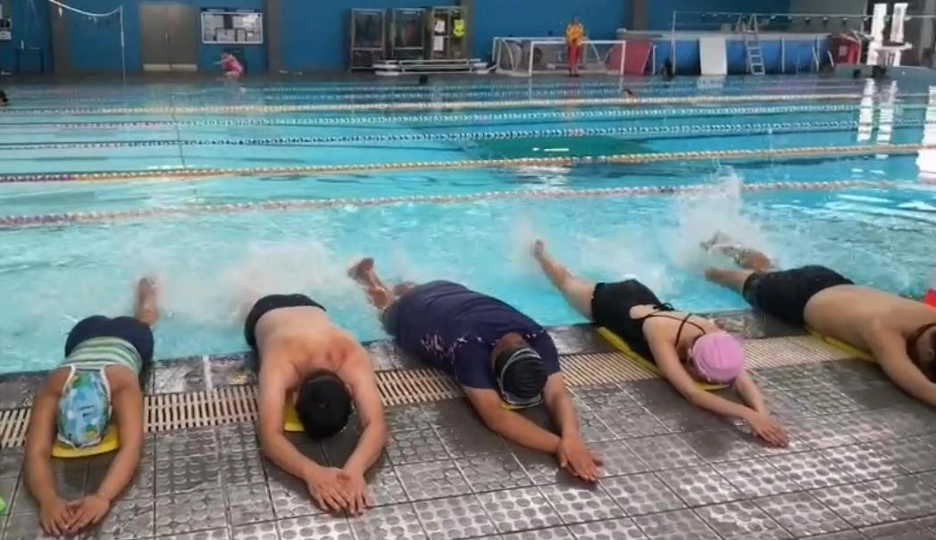





Freestyle is often praised for its cardiovascular benefits, but what many are not aware of is how amazingly efficient it is at building lean, functional muscle. It's one of the few things that can be done for nearly every major muscle group in your body, and it accomplishes that without overly stressing your joints.

If you're looking for low-impact, high-payoff swimming lessons that develop your whole body, here's what you need to know about muscle freestyle swimming and how it pays off in the long run.
Let's take it apart, muscle by muscle.
The first-place swimmers tend to feel it on their shoulders.
Freestyle involves a continuous overhead motion. That motion is powered mostly by the front of your shoulder, the anterior deltoid. It reaches, pulls, and then recovers out of the water again and again. But it’s not just one part of the shoulder doing the job. The deeper muscles around the shoulder blade, like the rotator cuff group and the trapezius, are constantly stabilising your arm during each stroke.
Without them, your stroke would feel sloppy and weak. If you’ve ever had shoulder fatigue or soreness after swimming, it wasn’t random. That burn is your delts and stabilisers doing their job. And over time, they get stronger without you having to isolate them in the gym.

You might not feel your back firing while but it’s working constantly. The big muscles in your upper back, especially the latissimus dorsi, are responsible for pulling your body forward through the water.
When your hand enters and pulls, your lats contract to drive that motion. It’s powerful but smooth. This creates that classic swimmer’s V-shape, wide at the top and lean at the waist - one of the many benefits of training with the best swimming strokes for muscle development.
Along with the lats, muscles like the rhomboids and the lower traps help maintain good posture and form. They pull your shoulders back and keep everything aligned while you rotate. That kind of coordination builds a back that’s strong, functional, and balanced.
Swimming doesn't appear to be a core exercise, but it is quietly so. Whenever you rotate your torso, breathe on the side, or prevent your legs from submerging, your core muscles are working hard.
The obliques deal with rotation. The deep transverse abdominis muscles stabilise your spine and pelvis. Even your rectus abdominis, the typical six-pack muscle, assists in keeping your body's straight line in the water.
The nicest thing about this is that it occurs without crunches or compressing the spine. You're developing endurance and control of your core simply by remaining streamlined and upright. And since your core is constantly contracting and expanding with the rest of your body, the strength you achieve carries over directly to daily life.
If you’ve ever done laps and felt a dull ache in your but afterwards, that wasn’t an accident. Freestyle kicks start at the hips, not the knees. That means your glutes, especially the gluteus maximus, are firing with every kick.
They assist in keeping your legs straight and provide power to your flutter kick. They also prevent your lower body from dragging in the water. Weak glutes make your hips drop, resulting in an inefficient stroke. It’s something you’ll notice quickly in squad training where technique and endurance get pushed harder.
It sneaks up on you at first, but eventually, your glutes become stronger. Not like squats or lunges help you gain mass, but they help you gain control and endurance. And strong glutes serve more than to assist you in swimming. They defend your lower back and make you move better throughout the day.

Your legs never actually cease to move in freestyle. The flutter kick appears effortless and light, but it engages your hip flexors, quads, hamstrings, and calves. Each of them takes turns keeping you in balance and moving ahead.
The hip flexors raise the leg. The quads extend it. The hamstrings assist in drawing it back. And all of this takes place in a consistent, rhythmic cycle.
Since your legs are level, they do not have to withstand impact like they do in running. What that means is that you can develop muscular endurance in your legs without putting excessive stress on your joints. It's wonderful for those who want strength with no wear and tear.
Each time your feet move, your calf muscles engage. The flutter kick engages the gastrocnemius and soleus muscles, stabilising your lower legs.
Your ankles become more flexible, too. Swimmers tend to have more flexible ankles than lifters or runners. And that flexibility is important: it allows your foot to behave like a fin, producing smoother movement and less drag.
It may not be the type of leg day you'll feel right away, but eventually, these little muscles develop endurance. And it all counts.
Freestyle swimming develops lean muscle in a sustainable, kind way. Here's why it stands out:
The strength you build through swimming assists you in sitting up straight at your workstation, bagging groceries without a twinge, and functioning more smoothly throughout your environment. It's a strength that aids you in the background, but constantly.
Freestyle swimming is one of the most complete forms of exercise. It works your shoulders, back, core, glutes, hips, legs, and even your feet. But more importantly, it teaches your body how to move well.
So the next time you're in the water, remember this: every kick, every stroke, every breath is part of an entire-body conversation. One that makes you stronger, more relaxed, and more aware of your body than when you began.
Ready to take your swim training to the next level? At Aqua Artist, we design high-performance swimwear and accessories meant to glide with you in and out of the water. Join us today and experience the difference!
Absolutely. Freestyle engages major upper body muscles like the lats, shoulders, and triceps. If you’re focused on strength, a private lesson can help fine-tune your stroke for maximum muscle engagement.
Yes, especially for core strength and coordination. In a well-structured preschool lesson, kids learn proper kicking and body positioning, which helps activate key muscle groups even at an early age.
If your shoulders, back, and glutes ache like they've been exercising, chances are you're going in the right direction. Not convinced yet? You can get a free assessment from a swimming coach to scan your form and muscle usage.
That's a great sign! Freestyle kicks originate in the hips, not the knees, so your glutes (particularly the gluteus maximus) are working all the time. Private instruction can correct posture and prevent overuse.
Yes, they can, if properly instructed. A solid preschool lesson deconstructs freestyle into engaging, bite-sized drills that build a foundation for powerful, safe movement and whole-body use.